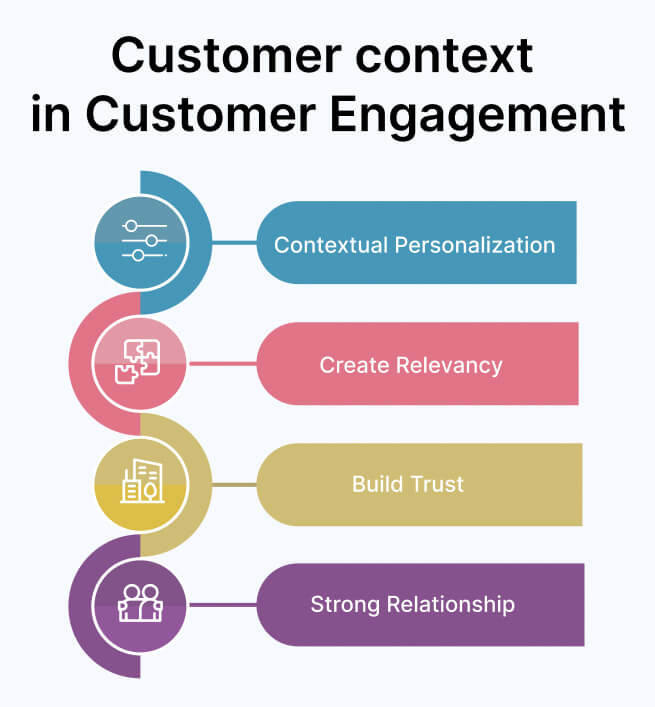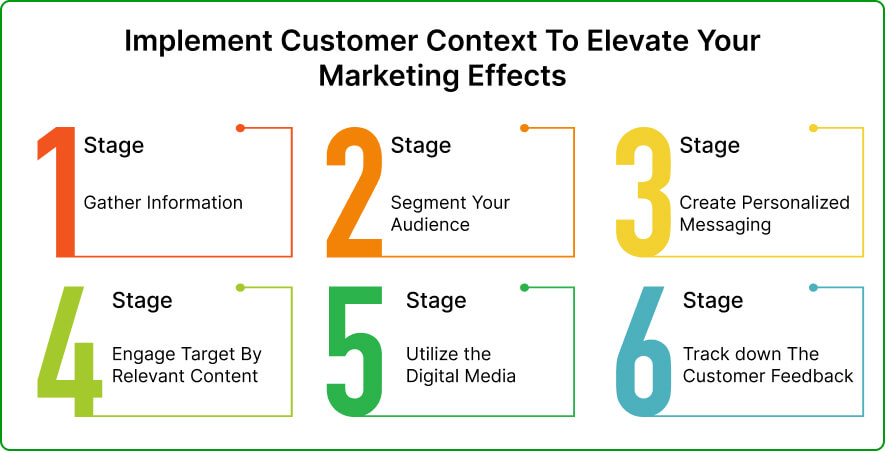 Customer Experience
Customer Experience

28 December, 2023

In today’s dynamic business landscape, we know how much it is challenging for a business to meet the ever-evolving expectations of its customers. Even more when the core success of the brand heavily relies on personalized customer experience, derived from their insights. If you find yourself in these hurdles to manage customer expectations, make sure your business lacks the power of customer context.
Now, consumers are valuing and seeking out businesses that customize their offerings to their individual needs and preferences. Even Smith.ai says that companies prioritizing a customer-centric approach achieve higher profitability (about 60%) compared to those who don’t!
So, this is the term that must not miss out! Let’s uncover all about customer context definition, the ultimate benefits, and the effective process to utilize this concept to stand out in today’s competitive market.
Contents
Before diving deeper, let’s start with the customer context meaning, and definition of it.
Customer context is the popular marketing term that gives a detailed overview of the customer’s preference for a product, what they expect, and their overall experience with the brand.
It is an important term in marketing that allows businesses to access the customer’s needs as per their preferences even at the right time.
For example, in an e-commerce business, information gathered about customer behavior and experience about their last purchasing journey helps the businesses recommend products to customers’ needs.
For instance, website browsing, app usage, surveys, and feedback play vital roles as context marketing media or channels.
In the context of customer relationship management (CRM) of a business, customer context is essential for personalization and delivering customers a more relevant and engaging experience. Here, the context refers not only to basic demographic information about the customers but also encompasses the entire journey, including their preferences, likes, and interests for a specific product.
Customers are more likely to engage with content and messages that are relevant to their current situation, needs, or interests.
By focusing on this context, businesses can manage and provide information that matters to the customer at a particular point in time. When the customers find themselves value their preferences, they feel special and more likely to remain loyal to a brand over the long term.
Understanding a customer’s context is also important to improving good customer service. When you know about your customers’ usage history and previous interactions, you can address issues more efficiently and provide relevant solutions that ultimately enhance customer satisfaction.

Wondering, but it’s a fact that contextual marketing plays a vital role in increasing customer engagement for a brand or company. This is more likely when you help your customers achieve their goals, the more they will come back to you again and again or recommend others about your brand.
Here are a few key points defining how a context creates new customer connections to your business.
Contextual personalization allows marketers to ensure the actual demand of the customer when they need it, even though it is their preferred medium. This short process helps them to interact more and more consumer with their products.
According to the BCG Boston Consulting Group, over the next five years, up to $800 billion will shift away from about 85% of companies that are failing to offer personalized experiences to consumers. Source
When you understand your customers’ context, you can make sure that your content and communications are relevant to them. This means there will be no chance of sending them generic messages that would look like spam to them.
Instead, they want to know what else you know about them and what solution you will bring. This curtly helps your customers stay engaged.
When your customers know that you care about their needs, they’re more likely to trust you. This is crucial for building strong relationships with your customers and encouraging them to continue business with you.

So far, we’ve gone through the basics and importance of customer context. Now, your question would be how you will take advantage of context marketing opportunities.
Well, it’s nothing but implementing some effective actions. For instance, here are a few steps you can take to boost your business through context marketing:
Your first step would be collecting as much data about your customer as possible. For instance, you may need to go through surveys, website tracking, social media monitoring, and even customer interviews, which are effective for this.
Another good approach would be to conduct one-on-one interviews or automated customer support where you will live chat with customers to gain deeper insights into their motivations and challenges.
Once you’ve data, you can segment your audience into groups based on shared characteristics. This will help create targeted campaigns that reflect each segment.
This is the time, you can use the customer data to personalize your marketing messages and content to let new users about your product. This would be done like:
That’s not all enough to engage your target. Now, you can craft content that is relevant to your customer segments. Here, you can highlight their specific pain points and interests according to your customer context analysis.
Digital customer engagement is one of the effective processes to elevate your business. You need to reach your customers on the digital channels they use most. This includes email, social media, paid advertising, or even direct mail.
Last but not least, track the results of your marketing campaigns. It will help you understand what’s working and what’s not and refine your approach accordingly.
A survey shows that up to 60% of businesses notch growth due to good customer service.
[Even Fortune Business Insights expects global market growth from $11.34 billion to $32.53 billion in 2029 due to increased interaction between customers and customer service centers.] source
Successful brands truly understand that one-size-fits-all marketing doesn’t work anymore. By practicing consumer context purely and continuously refining the approaches, one can easily achieve the true brand goal.
Here are a few customer context marketing examples that you should know for the ultimate success of your brand:

Now that you know about content marketing and how it can benefit you, the time is to take effective courses of action. For instance, context-driven campaigns would be the best start.
This starts by understanding your issues and their insights. Collect and make a list of all the real-time information as much as you can. By analyzing this data in real-time, you can now shape messaging to fit each customer’s context.
One of the successful brands that stands out for its context-driven campaigns is Nike. In 1988, their “Just Do It” campaign was amazing, where they targeted professional and amateur athletes sharing the stories and emotions they felt as they exercised. This helped them connect with a broad audience beyond just professional athletes.
A customer frequently engages with the brand on social media, liking and sharing posts. So as a marketer, you can acknowledge the customer’s loyalty by offering exclusive social media promotions, featuring them in user-generated content campaigns.
Also, through various social media tools, can monitor conversations, track hashtags, and analyze user-generated content related to your brand. This will provide you with valuable data about customer sentiments, opinions, and emerging trends.
Delivering your messages through running ads is another example of context marketing. This is more likely to refer to a targeted advertisement delivered to a user based on their real-time actions or behavior.
For example, you are playing a mobile game and see an ad for a similar game pop up during a loading screen. That means the ad recognizes your current activity and presents a relevant offer at the exact moment you might be open to it.
This increases the chances of engagement and conversion towards that app, and this is what ad-based content marketing is.
While context marketing offers an immense potential for personalized experiences and stronger brand relationships with customers, it isn’t free of challenges. Here are some key hurdles brands might face:
While you need to collect customer data from various systems like (CRM, website analytics, and social media platforms, sometimes it makes it difficult for marketers to obtain a detailed view of the individual context.
There remains a chance of inaccurate or incomplete data, which can lead to misleading insights and ineffective marketing efforts.
The proper data analysis depends on the right technologies for the right purposes. That should be designed specifically to solve a particular issue or overcome and help consumers achieve their goals.
In case the right technologies aren’t in place, it makes it difficult to Analyze the vast amounts of real-time data.
Customer centricity mainly starts with the internal customers that your team has. Lack of employee knowledge and triangle can be one of your biggest obstacles to getting the right customer data to get in, ultimately making it challenging to achieve CX.
Implementing context-driven marketing requires adapting internal processes and skillsets to personalize communication and respond to real-time customer behavior effectively.
At times, marketers find themselves in trouble to face the customer’s demands. Sometimes, their demands are so high that you can’t fulfill them technically or financially, and any costly features can’t be built in.
They could stem from misunderstanding or unrealistic expectations. This can lead to inaccurate data and misinterpretations of customer context. In worst cases, unreasonable demands can damage the relationship between the customer and the brand.
Looking for the best customer context analysis & management tools for your SaaS business? Here are a few effective customer context technologies you can start with:

HubSpot is a leading SaaS marketing automation tool that helps businesses achieve their marketing goals. In the case of context marketing, it helps businesses to create, manage, and optimize campaigns across multiple channels in a very streamlined way.
Marketers can easily understand customer behavior and twerk their strategies accordingly.
It offers robust analytics tools to track user behavior on your website, revealing insights like page views, clicks, and conversion paths. This allows you to manage your content and offers them based on how users interact with your site. It often integrates with other tools for a more comprehensive view.
Key Features
Pricing: In addition to a robust free plan, the basic plans start at only $20 per month

The segment is another industry-leading customer data platform that helps marketers personalize their marketing campaigns. It creates customer attributes based on who they are, how they behave and their specific characteristics.
Using such strategic segmentation, a business can reach its target audience with personalized offers, messaging, or production.
Moreover, it connects your businesses with various platforms like website forms, online stores, and email marketing campaigns and helps to pull customers from these platforms.
Key Features:
Pricing: As with the free version, the basic Team plan starts at only $120/month

Google Analytics is one of the best data analytics tools that analyze customer behavior and track key performance indicators, best for customer context analysis.
By monitoring important metrics like conversion rate and time on page, it lets you know all the data on customer behavior and engagement. After analyzing user behavior, you can understand what content or products are most popular which allows you to optimize marketing messages to specific interests.
The tool also allows you to create custom segments based on user attributes, behaviors, and demographics.
What’s more? It will provide you with a clear insight into where you are getting traffic to your websites. Whether they are from search engines, social media, or direct visits. It would be a great source for you to optimize your marketing strategies for each channel.
Key Features:
Have a short glimpse at other key features of the Google Analytics tool:

If you are seeking an effective tool to automate your marketing tasks and campaigns, ActiveCampaign would be a great start for you. It helps automate marketing tasks, trigger personalized campaigns based on customer context, and track engagement and results.
It is a Chicago-based software-as-a-service (SaaS) platform founded in 2003. In addition to marketing automation, it offers an email marketing platform, customer relationship management (CRM), and sales engagement tools, allowing users to access a comprehensive marketing automation suite.
Key Features:
Pricing: It offers its premium plans in a few segments, where the entry-level plans start at $29 per month with annual billing options.

Hootsuite is a leading social media marketing and management that helps in your customer context marketing by scheduling posts across all the social networks in just a few clicks.
Up to 2023, over 33074 companies around the world are using Hootsuite as a Social Media tool to interact with consumers.
Using these amazing tools, you can easily know about the latest social conversations, trends, and brand mentions as well as communicate with your timer through social platforms.
Even with a unified inbox system, you can quickly respond to the comments of your customers. Another notable feature of Hootsuite is its keyword monitoring capabilities that enable businesses to track specific topics or trends relevant to their industry.
Staying informed about industry trends helps you keep in mind customer interests and adapt strategies accordingly.
Key Features:
Pricing: Hootsuite offers its premium plans in a few tiers where you can start with the professional plan at only $99/month.
Ans. Businesses can collect customer context data through various channels such as websites, mobile apps, social media, surveys, and customer support interactions. Customer Relationship Management (CRM) systems and Customer Data Platforms (CDP) can also be used to manage this data.
Ans. While collecting data, businesses can maintain customer privacy by implementing technical privacy measures like encryption, secure storage systems, or firewalls. Also, it’s better to create a privacy policy that outlines data collection, usage, retention, and disposal practices.
Additionally, businesses can conduct regular security audits, Train employees regarding data privacy, or apply effective steps to manage data access from third-party vendors.
Ans. Yes, definitely, businesses can use customer context to identify loyal customers and understand their preferences. This helps them to manage their retention strategies based on context and keep the customer engaged toward the products.
With the proper implementation of the Customer context, a business can develop individual profiles that provide a clear picture of your brand’s ideal customers. The deeper the data on customer profiles, the better customers you will find, allowing you to better execute your next approaches.
Keep note that, customer context is like a game changer in not only engaging more and more customers towards your brand but also building a strong relationship between individuals and your brand!